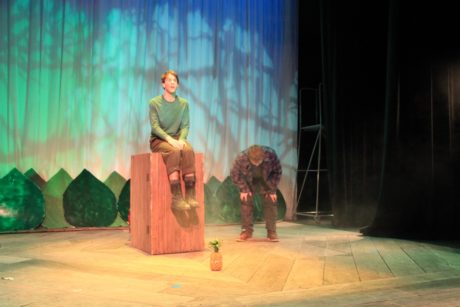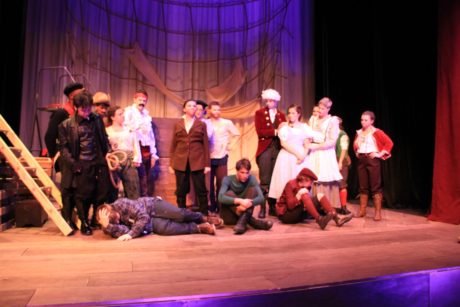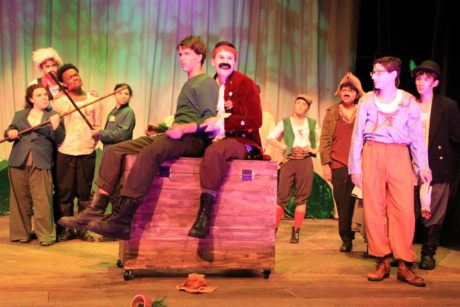If the idea of “sophisticated family entertainment” sounds like a contradiction in terms—an oxymoron if ever there were one—then Peter and the Starcatcher, which just opened for a quick run at Georgetown Day School, may be just what the modern multi-generational group needs.
That’s because this production combines youthful energy with professionalism, providing the kind of broad comedy—with bits of satire—that even the most action-sated middle school kids and their grownup caretakers will enjoy.

The play captured five Tony Awards on Broadway in 2012, and is a prequel to J. M. Barrie’s original Peter Pan, first staged in 1904.
Based on the book by Dave Barry and Ridley Pearson and adapted for the stage by Rick Elice and Wayne Barker, the show is also a tribute to Gilbert and Sullivan’s The Pirates of Penzance, with lots of showstopping salutes to Her Majesty, Queen Victoria.
Boisterous and lyrical by turns, Peter and the Starcatcher explains, in hilarious detail, how Peter, Wendy, and Captain Hook got to be who they are. Along the way there are shipwrecks, flying cats, crocodiles, stolen treasures, a mysterious island and a cadre of mermaids in wigs.
Peter, in this version, is a nameless orphan. He is one of three ‘lost boys’ sold to Slank—the sinister captain of a beat-up old boat called the Neverland—and shipped, inside a wooden crate, to the remote land of Rundoon.
Played by Alex Carnot, Peter turns from being an ordinary orphan—homeless, nameless and unable to swim—to a hero able to save the day (along with the heroine, her father and the Queen.)
The Starcatcher is Molly, the 14-year-old precocious—but lonely—daughter of Lord Aster, who has been tasked by the Queen (God Save her) to deliver bits of fallen stars to a safe location.
Actually, Molly is not yet a full-blown starcatcher. She’s still learning, following lessons taught by her father—played by Jamie Hedlund in a barrister’s wig that keeps threatening to fall off—in secret languages, such as the Norse (being the Norwegian version of Morse) Code.

As played by Katie Abramowitz—who bears a startling resemblance to the young Sarah Jessica Parker, with a voice clear as a bell, a British accent that sounds genuine and facial expressions that speak volumes—Molly is determined to save both the star fragments and the lost boys, all while doing as her father says.
Andrew Spafford brings a booming voice and a gentleman’s swagger to the role of ‘Stache,’ the mustachioed pirate who is driven mad by the children marshalled against him.
Two of the funniest characters in this spoof are Smee, the pirate chief’s bumbling assistant, and Mrs. Bumbrake, Molly’s uptight nanny, assigned to protect her on the voyage. Simon Diesenhaus is the comedian who plays Smee as a malevolent clown. At times, he leers at the audience and adds a gender-bending cast to the role, resembling a man who is playing a woman who is playing a man. Smee is always funny, but never more so than when he dons a wig and pretends to be a mermaid playing the ukele.
Eli Kaplan, in a role actually written for a female impersonator, is the British nanny who issues tremulous orders in a quavering, falsetto voice.
Cross-dressing is a given in this production. While the Broadway version of the play had 11 men and one woman, the GDS version has been expanded to 18, with seven roles for women.
However, Director Laura Rosberg, who is also head of the entire Performing Arts Department at the high school division of GDS—wanted to strengthen the teaching component by casting as many of the actors as possible in opposite gender roles.
As a result, Eva Brickman—previously cast in GDS plays as an ingenue—is seen in this production as the evil school master who sells the boys into slavery. She sneers throughout and, at one point, whips poor Peter into subservience. (Full disclosure: Eva is a relative of mine.)
Other women cast as men include Prentiss, one of the lost boys, who is played by Maaike Laanstra-Corn. She is the one who tries to be the orphans’ leader, losing out, ultimately, to Molly, who understands the power of bedtime stories.
Ted, the third orphan boy, is played by Nico von Friedeberg, who cares more about food than heroism and who spend much of the play trying to figure out how to eat a pineapple.
Alex Hewlett plays the greedy captain of the Neverland, while Brion Whytle is the virtuous Captain Scott. Karla Sagastizado, Bess Epstein, Tess Thornton, and Calah Delaney all don men’s clothing while Sam Brodsky, Cole Wright-Schaner, and Andrew White round out the cast in a variety of roles, some of them fishy.
The real stars of Peter and the Starcatcher are backstage In fact, the technical crews, directed by Will Ley, outnumber performers by roughly three-to-one.
The giant crocodile, for example, is the creation of Lighting Designers Avery Adomaitis and Lola Phillips, working with a crew of seven to create a terrifying image of eyes and teeth.
Sarah Lev is the set designer who—with a crew of 15—has created the crocodile’s lair made entirely of ropes as well as a backdrop that resembles the mast of a sailing ship.
The costumes throughout are wonderful, often serving as visual jokes on their own. Molly starts out looking like Alice in Wonderland, but she is transformed—perhaps because of her allegedly pure love for Peter—into a siren dressed for burlesque.
One of the funniest scenes involves a dozen mermaids, wearing wigs and breast plates, who sing a Hawaian-style ode to their new status (“Mermaid Outa Me”). It’s straight out of vaudeville.
Billed as a play with music, Peter boasts some of the most riotous Busby Berkeley-style numbers. The entire cast—in a tribute to old Hollywood movies—dances behind umbrellas or creeps up and down a mountain, carrying giant leaves.
During the storm, the two ships collide. As the victims—heroes and villains alike—struggle to reach the shore, they manage to sing an anthem called “Swim On.”
Maria Watson is the faculty choreographer who works with students Elena Pastreich and Rosie Lichtenbaum, the stage managers, to fit all this movement onto a tiny stage. Actors occasionally pop up in the balcony or behind the orchestra seats to make startling announcements.
Music Director Maureen Codelka—known as Reenie—plays the keyboard in the show’s orchestra. Reenie, who works with both the theater department and the school choir, is also a music director at Toby’s Dinner Theatre in Columbia.
Her sidekick is German-born percussionist Sven Abow, who performs at jazz clubs as well as at GDS. He’s been drumming at the school for roughly 16 years and is originally from Offenbach am Main.
Ben Steinwurtzel and Nick Moen are the student sound experts who work with the musicians to create the ominous tones of a storm at sea or a hungry crocodile.
There are roughly 90 students involved in this production. In addition to all the creative and technical lessons, the school teaches the business side of production.

“The average cost of a single GDS musical is $40-45,000,” says Rosberg, who oversees 17 full credit courses at the school. “Much of that goes for royalties and rentals. Students quickly learn that you can’t spend what you don’t have!”
Andrew White is the student producer who heads the business team, which raises money through advertising and fund-raising.
I asked Rosberg why Peter and the Starcatcher is enjoying so much popularity now.
“That’s because it’s true ensemble theater, with most of the cast on stage for most of the time,” she explained. “It’s also a great way to teach some of the less wellknown arts, such as makeup, for example.” (Makeup alone involves 16 students with Cecily Davis as designer.)
Although the current audience is made up principally of families of current and past students, GDS is now looking beyond its “insider” group for other audiences. Families with school age children will find this a welcome addition to the professional children’s theaters in the DC area.
Running time: Two hours and 30 minutes, with one intermission.
Peter and the Starcatcher plays through November 19, 2016 at Georgetown Day School – 4200 Davenport Street, NW, in Washington, DC. For tickets, call the box office at (202) 274-3199, or purchase them online.





Great review, Ravelle. I am looking forward to seeing this show!